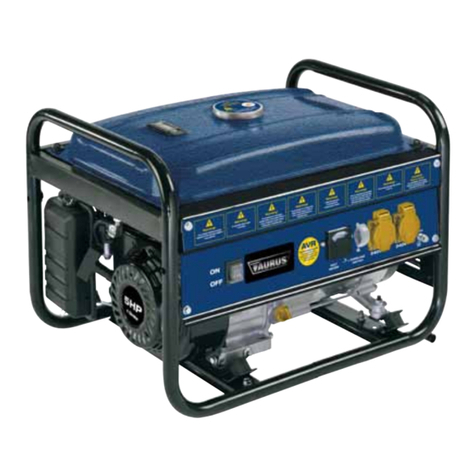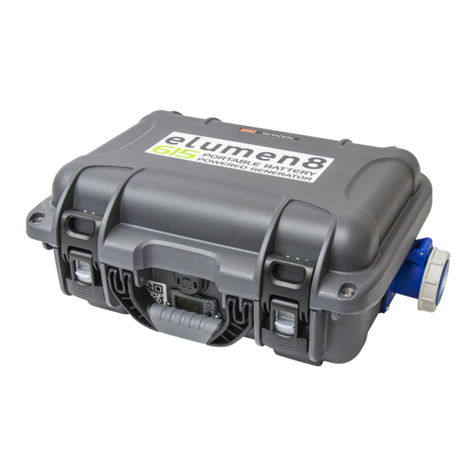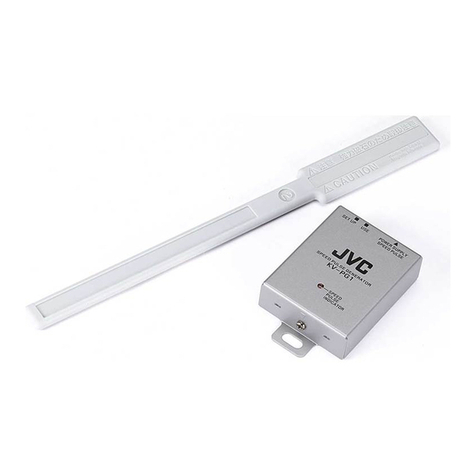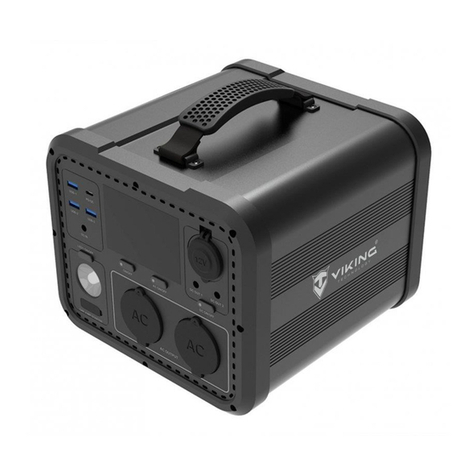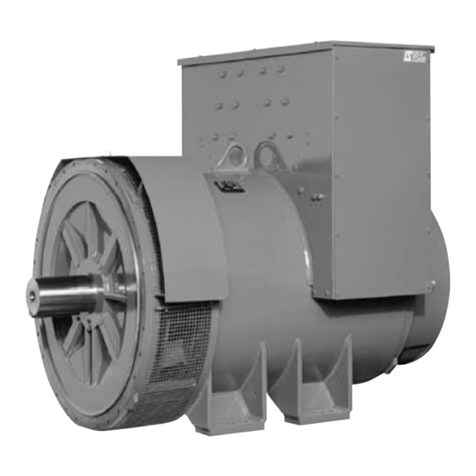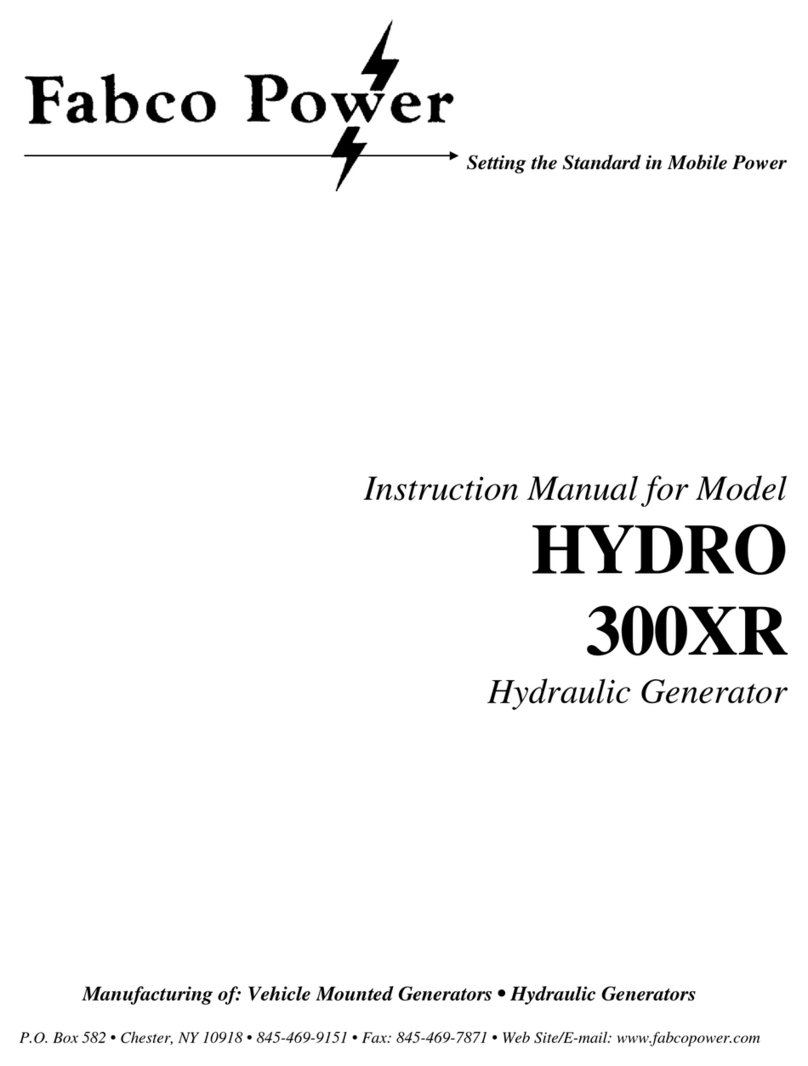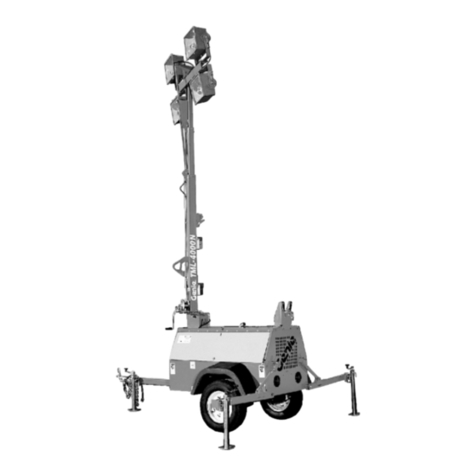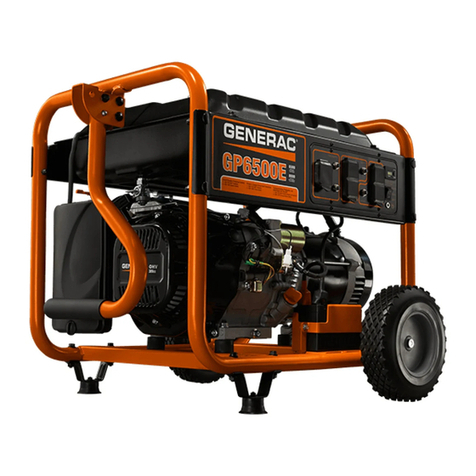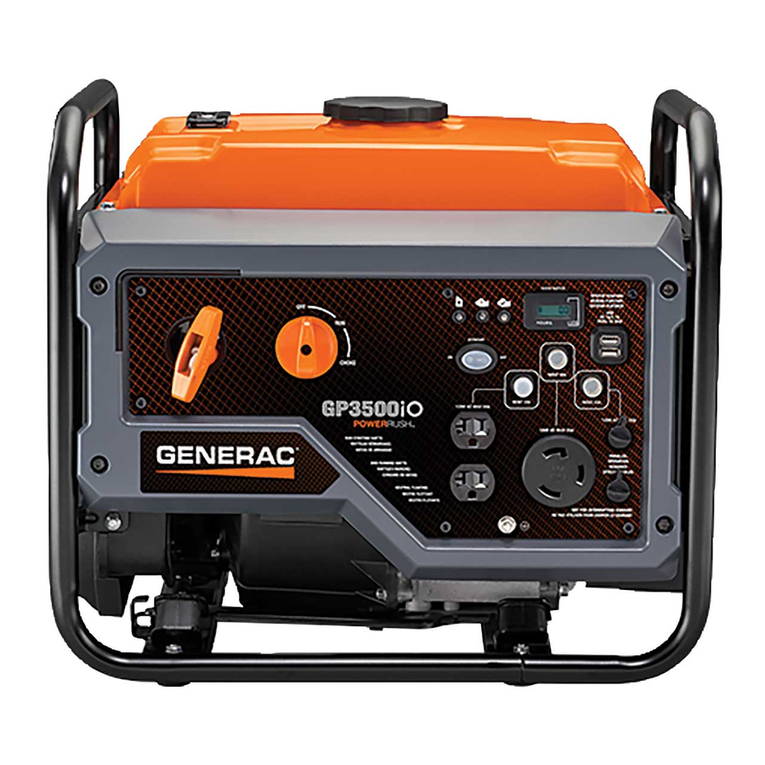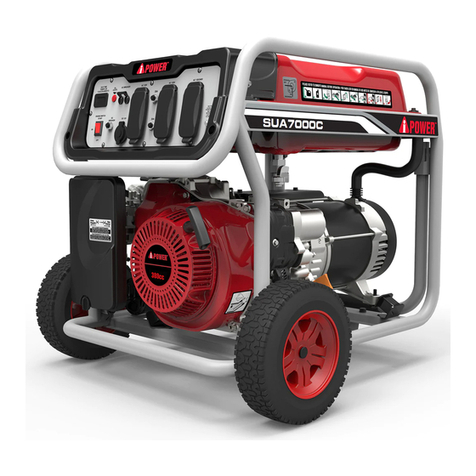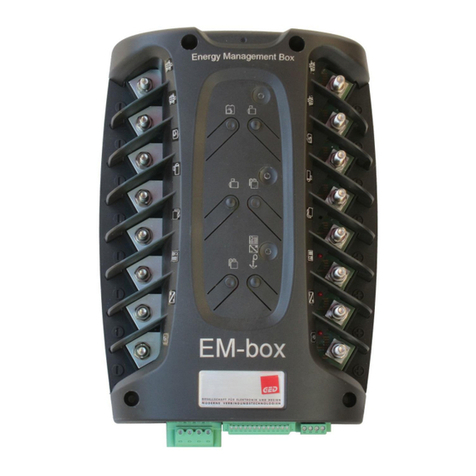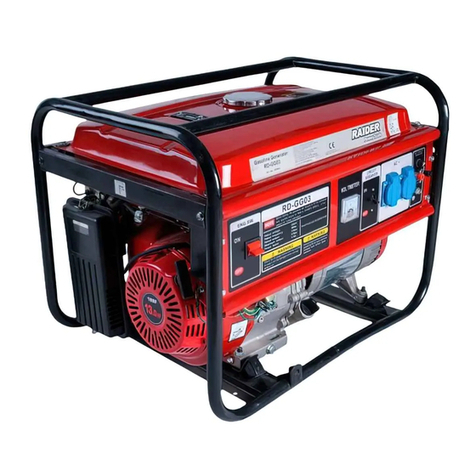Taurus BT-PG 900 User manual

AFTER SALES SUPPORT
1
N26704
1000W
DIGITAL INVERTER GENERATOR
INSTRUCTION MANUAL MODEL NUMBER BT-PG 900
AFTER SALES SUPPORT
TEL: 1300 922 271
EMAIL: [email protected]

AFTER SALES SUPPORT
2
Digital Inverter Generator
What your 1year warranty means
Great care has gone into the manufacture of this product and it should therefore provide you with years
of good service when used properly. In the event of product failure within its intended use over the
course of the rst 1year after the date of purchase, we will remedy the problem as quickly as possible
once it has been brought to our attention. In the unlikely event of such an occurrence, or if you require
any information about the product, please contact us via our after sales support services, details of
which can be found in this manual and on the product itself.
There will be no returns accepted with products containing fuel.
Welcome Section
Congratulations on choosing to buy a TAURUS® product.
All products brought to you by TAURUS® are manufactured to the highest standards of performance and
safety, and, as part of our philosophy of customer service and satisfaction, are backed by our
comprehensive 1Year Warranty.
We hope you will enjoy using your purchase for many years to come.
Table of Contents
1. General safety instructions Pg. 6
2. Special safety instructions Pg. 7
3. Layout and items supplied Pg. 8
4. Proper use Pg. 8
5. Technical data Pg. 8
6. Before putting the machine into operation Pg. 8
7. Operation Pg. 9
8. Cleaning, maintenance and ordering spare parts Pg. 10
9. Disposal and recycling Pg. 11
10. Servicing petrol tools Pg. 11
11. Troubleshooting Pg. 12

AFTER SALES SUPPORT
6
1. GENERAL SAFETY RULES
SAVE THESE INSTRUCTIONS
1. Work area
a. Keep work area clean and well lit. Cluttered and
dark areas invite accidents.
b. Do not operate power tools in explosive
atmospheres, such as in the presence of
ammable liquids, gases or dust. Power tools
create sparks which may ignite the dust or fumes.
c. Keep children and bystanders away while
operating a power tool. Distractions can cause
you to lose control.
2. Electrical safety
a. Power tools plugs must match the outlet. Never
modify the plug in any way. Do not use any
adapter plugs with earthed (grounded) power
tool. Unmodified plugs and matching outlets will
reduce risk of electric shock.
b. Avoid body contact with earthed or grounded
surfaces such as pipes, radiators, ranges and
refrigerators. There is an increased risk of electric
shock if your body is earthed or grounded.
c. Do not expose power tools to rain or wet
conditions. Water entering a power tool will
increase the risk of electric shock.
d. Do not abuse the cord. Never use the cord for
carrying, pulling or unplugging the power tool.
Keep cord away from heat, oil, sharp edges
or moving parts. Damaged or entangled cords
increase the risk of electric shock.
e. When operating a power tool outdoors, use an
extension cord suitable for outdoor use. Use of a
cord suitable for outdoor use reduces the risk of
electric shock.
3. Personal safety
a. Stay alert, watch what you are doing and use
common sense when operating a power tool. Do
not use a power tool while you are tired or under
the inuence of drugs, alcohol or medication. A
moment of inattention while operating power tools
may result in serious personal injury.
b. Use safety equipment. Always wear eye protection.
Safety equipment such as a dust mask, non-skid
safety shoes, hard hat, or hearing protection used
for appropriate conditions will reduce personal
injuries.
c. Avoid accidental starting. Ensure the switch is in
the off-position before plugging in. Carrying power
tools with your finger on the switch or plugging
in power tools that have the switch on invites
accidents.
d. Remove any adjusting key or wrench before
turning the power tool on. A wrench or a key left
attached to a rotating part of the power tool may
result in personal injury.
e. Do not overreach. Keep proper footing and
balance at all times. This enables better control of
the power tool in unexpected situations.
f. Dress properly. Do not wear loose clothing or
jewellery. Keep your hair, clothing and gloves
away from moving parts. Loose clothes, jewellery
or long hair can be caught in moving parts.
g. If devices are provided for the connection of dust
extraction and collection facilities, ensure these
are connected and properly used. Use of these
devices can reduce dust-related hazards.
4. Power tool use and care
a. Do not force the power tool. Use the correct power
tool for your application. The correct power tool
will do the job better and safer at the rate for which
it was designed.
b. Do not use the power tool if the switch does not
turn it on and off. Any power tool that cannot be
controlled with the switch is dangerous and must
be repaired.
c. Disconnect the plug from the power source and/
or the battery pack from the power tool before
making any adjustments, changing accessories,
or storing power tools. Such preventive safety
measures reduce the risk of starting the power tool
accidentally.
d. Store idle power tools out of the reach of children
WARNING! Read all instructions Failure to
follow all instructions listed below may result
in electric shock, fire and/or serious injury. The
term ’’power tool’’ in all of the warnings listed
below refers to your mains-operated (corded)
power tool or battery-operated (cordless) power
tool.
13

AFTER SALES SUPPORT
7
and do not allow persons unfamiliar with the
power tool or these instructions to operate the
power tool. Power tools are dangerous in the
hands of untrained users.
e. Maintain power tools. Check for misalignment or
binding of moving parts, breakage of parts and
any other condition that may affect the power
tools operation. If damaged, have the power tool
repaired before use. Many accidents are caused
by poorly maintained power tools.
f. Keep cutting tools sharp and clean. Properly
maintained cutting tools with sharp cutting edges
are less likely to bind and are easier to control.
g. Use the power tool, accessories and tool bits etc.
in accordance with these instructions and in the
manner intended for the particular type of power
tool, taking into account the working conditions
and the work to be performed. Use of the power
tool for operations different from those intended
could result in a hazardous situation.
Important!
When using the equipment, a few safety
precautions must be observed to avoid injuries
and damage. Please read the complete operating
instructions and safety regulations with due care.
Keep this manual in a safe place, so that the
information is available at all times. If you give the
equipment to any other person, hand over these
operating instructions and safety regulations as
well. We cannot accept any liability for damage
or accidents which arise due to a failure to follow
these instructions and the safety instructions.
Explanation of the warning signs on the machine
(Fig. 13)
1. Important. Read the operating instructions.
2. Important. Hot parts. Keep your distance.
3. Important. Switch off the engine before refuelling.
4. Important. Never operate in non-ventilated rooms.
2. Special safety instructions
• No changes may be made to the generator.
• Only original parts may be used for maintenance
and accessories.
• Important: Danger of poisoning, do not inhale
emissions.
• Children are to be kept away from the generator.
• Important: Risk of burns. Do not touch the exhaust
system or drive unit.
• Wear suitable ear protection when in the vicinity
of the equipment.
• Important: Petrol and petrol fumes are highly
combustible or explosive.
• Never operate the generator in non-ventilated
roomsorinthevicinityofeasilyinammable
substances. When operating the generator in
rooms with good ventilation , the exhaust gases
must be channeled directly outdoors through an
exhaust hose.
• Important: Toxic exhaust gases can escape
despitetheexhausthose.Duetothere
hazard, never direct the exhaust hose towards
inammablematerials.
• Risk of explosion: Never operate the generator in
rooms with combustible materials.
• The speed preset by the manufacturer is not
allowed to be changed. The generator or
connected equipment may be damaged.
• Secure the generator against shifting and toppling
during transport.
• Place the generator at least 1m away from buildings
and the equipment connected to it.
• Place the generator in a secure, level position.
• Do not turn, tip or change the generators position
while it is working.
• Always switch off the engine when transporting
and refuelling the generator.
• Make sure that when you refuel the generator no
fuel is spilt on the engine or exhaust pipe.
• Never operate the generator in rain or snow.
• Never touch the generator with wet hands.
• Guard against electric danger. When working
outdoors, use only extension cables that are
approved for outdoor use and which are marked
accordingly (H07RN..).
• The overall length of the extension cables used
may not exceed 50 m for 1.5 mm2and 100 m for
2.5 mm2.
• No changes may be made to the settings of the
motor or generator.
• Repairs and adjustment work may only be carried
out by authorized trained personnel.
• Do not refuel or empty the tank near open lights,
reorsparks.Donotsmoke!
• Do not touch any mechanically driven or hot parts.
Do not remove the safety guards.
• Do not expose the tools to damp or dust.
• Permissible ambient temperature – 10 to + 40°
C, max. altitude above sea level 1000 m, relative
humidity: 90 % (non-condensing)
• The generator is driven by a combustion engine,
which produces heat in the area of the exhaust (on
the opposite side of the sockets) and the exhaust
outlet. You should therefore keep clear of these
surfaces because of risk of skin burns.
• The values quoted in the technical data for sound
power level (LWA) and sound pressure level
(LpA) are emission values and not necessarily
reliable workplace values. As there is a correlation
between emission and immission levels, the
values are not a reliable basis for deciding on any
additional precautions which may be needed.
Factorsinuencingtheactualuserimmissionlevel
include the properties of the work area, other
sound sources etc., the number of machines and
other processes in the vicinity, as well as the time
span in which the operator is subjected to the
noise. Also, the permitted immission level can
vary from country to country. Nevertheless, with
this information the user is able to make a better
assessment of the dangers and risks involved.
• Never use a faulty or damaged electrical equipment
(this also applies to extension cables and plug
connections).
CAUTION!
Read all safety regulations and instructions.
Any errors made in following the safety regulations
andinstructionsmayresultinanelectricshock,re
and/or serious injury.

AFTER SALES SUPPORT
8
5. Technical data
Generator: Digital Inverter
Protection type: IP23
Continuous rated power Prated (S1)
(240V):
900 W
Maximum power Pmax (S2 2 min)
(240 V):
1000 W
Rated voltage Urated: 1 x 240V~/1 x 12 V d.c.
Rated current Irated:4 A (240 V) / 6 A (12 V)
Frequency Frated: 50 Hz
Drive engine design: 4-stroke, air-cooled
Displacement: 52.6 cm3
Max. power: 1.04 kW / 1.4 hp
Fuel: Unleaded
Tank capacity: 2.7 L
Engine oil: approx 0.25 L
SAE 30
Consumption at 2/3 load: approx. 0.68 l/h
Weight: 13 kg
Sound pressure level LpA: 74 dB(A)
Sound pressure level LWA: 94 dB(A)
Power factor cosϕ: 1
Power class: G1
Max temperature: 40° C
Max. altitude (above sea level): 1000 m
Spark plug: CR4HSB
Operating mode S1 (continuous operation)
The machine can be continuously operated with the
quoted power output.
Operating mode S2 (temporary operation)
The machine may be temporarily operated with the
quoted power output. Afterwards the machine must
be stopped for a while to prevent it from overheating.
6. Before putting the machine
into operation
Remove the packaging material and check that all items
havebeensupplied.Placethegeneratoronarm,at
surface near the consumer and ensure proper ventilation.
6.1 Electrical safety:
• Electric supply cables and connected equipment
must be in perfect condition.
• The generator is to be operated only with
equipmentwhosevoltagespecicationsconform
with the generator’s output voltage.
Keep all safety regulations and instructions in a
safe place for future use.
Do not lose these safety instructions
3. Layout and items supplied
(Fig. 1-3)
1. Carry handle
2. Tank cover with ventilation
3. Petrol cock
4. Starter cord
5. Motor cover
6. Spark plug cover
7. ON/OFF switch
8. Earthing connection
9. Economy switch
10. 1 x 240V~ socket
11. 1 x 12V DC safety trip
12. 1 x 12V DC connector
13. Overload indicator
14. Operating status indicator
15. Oil warning indicator
16. Choke lever
17. Screwdriver handle
18. Screwdriver insert
19. Spark plug wrench
20. Adapter cable with 12V socket
21. Oilllerjug
22. Overload switch
4. Proper use
The unit is designed for applications operated with a
240 V~ and 12 V DC current source. Be sure to
observe the restrictions in the safety instructions.
The machine is to be used only for its prescribed
purpose. Any other use is deemed to be a case of
misuse. The user / operator and not the
manufacturer will be liable for any damage or injuries
of any kind caused as a result of this.
Please note that our equipment has not been
designed for use in commercial, trade or industrial
applications. Our warranty will be voided if the
machine is used in commercial, trade or industrial
businesses or for equivalent purposes

AFTER SALES SUPPORT
9
• Open the petrol cock (Fig. 5/Item 3) by turning it
horizontal.
• Move the POWER ON/OFF switch (Fig. 2/Item 7) to
the “I” position.
• Pull the choke lever (Fig. 1/Item 16) to the position
“choke”.
• Start the engine with the starter cord (Fig. 1/Item
4) by pulling the handle strongly. If the engine
does not start, pull the handle again. Important:
Always pull the starter cable slowly until you feel
the initial resistance before you then pull it quickly
to start the engine. Do not allow the starter cable
to whip back of its own accord.
• Push the choke lever (Fig. 1/Item 16) back
approximately 15 to 30 seconds after the engine
has started.
7.2 Economy mode
Economy switch (Fig. 2/Item 9) in the On “I” position:
The engine speed is regulated in accordance with
minimum power requirements and the generator runs
quietlyandefciently.
Economy switch (Fig. 2/Item 9) in the Off “O” position:
The generator runs at maximum speed.
7.3 Connecting consumers to the generator
• Connect the 240 V~ devices to be powered to the
socket (Fig. 2/Item 10). Important: This socket is
allowed to be exposed to a continuous (S1) load of
900 W and temporarily (S2) for a maximum of 2
minutes to a load of 1,000 W.
• Connect the 12 V DC devices to be powered to the
12 V DC socket (Fig. 2/Item 12) using the adapter
cable (Fig. 3/Item 20).
• Important: The 12 V socket is rated for 70 W.
• Important: The 12 V connector is allowed to be
used only when the economy switch is in the “0”
position.
• Do not connect the generator to the household
mains system, since this may damage the
generator.
Note: Some electrical appliances (power jigsaws,
drills, etc.) may have a higher level of power
consumptionwhenusedindifcultconditions.
7.4 Overload cut-out
240 V socket
• The status indicator (Fig. 2/Item 14) is lit green
during normal operation.
• An overload has occurred if the status indicator
light goes out and the overload indicator (Fig. 2/
Item13)ashesred.
• Switch off the generator (Fig. 2/Item 7).
• Press the overload switch (Fig. 2/Item 22).
Important: If an overload occurs, ensure that the power
drawn does not exceed the generators maximum power
output and that no defective devices are connected.
• Never connect the generator to the power supply
(socket-outlet).
• Keep the cable length to the consumer as short as
possible.
6.2 Environmental protection
• Dispose of soiled maintenance material and
operating materials at the appropriate collection
point.
• Recycle packaging material, metal and plastics.
6.3 Connecting to earth
• The generator must be connected to earth in
order to discharge static electricity to protect
the control panel. To do this, connect one end of
a earthing cable to the earth connection on the
generator (Fig. 2/Item 8) and the other end to an
external earth (for example an earthing rod). Note:
Cable and earthing rod are not supplied.
6.4 Topping up fuel
• Unscrew the tank cover (Fig. 1/Item 2) and add up
to2.7litersofunleadedpetrolusingallerneck.
Note: Do not use ethanol blended fuel as this may
result in engine failure.
• Ensurethatyoudonotoverllthetankandspill
petrol. (If you do spill, wipe up the excess amount
and wait until the vapors have evaporated –
danger of ignition.) Screw the tank cover back on.
6.5 Topping up oil
• Remove the engine cover (Figs. 6a - 6b/Item 5)
usingthescrewdriver.Opentheoilllerscrew
(Fig. 8/Item F) and add approximately 0.25 l of
engineoil(SAE30)usingthesuppliedoilllerjug
(Fig.3/Item21)oruntilthetopllmarkontheoil
dipstick (Fig. 7/Item D) is reached.
• Important! You must ll up with engine oil and
fuel before you can start the engine.
7. Operation
• Check the fuel level and top it up if necessary.
• Makesurethatthegeneratorhassufcient
ventilation.
• Make sure that the ignition cable is secured to the
spark plug.
• Inspect the immediate vicinity of the generator.
• Disconnect any electrical equipment which may
already be connected to the generator. Note: Do
not run the generator without load for any length
of time.
• Set the economy swithc (Fig. 2/Item 9) in the ON
“I” position (Section 7.2) to start the generator.
Once the generator is running, switch off the
economy switch (Fig. 2/Item 9) if you require
maximum speed.
7.1 Starting the engine
Important: Do not use any chemical starting agents
such as highly volatile fuels or similar.
• Move the ventilation switch on the tank cover to
the ON position (Fig. 4/Item A).

AFTER SALES SUPPORT
10
8.3 Automatic oil cut-out
• The engine will not start if it does not have enough
oil.
• If the engine is low on oil while it is running, the oil
warning indicator (Fig. 2/Item 15) will light up red
and the engine will stall. The oil indicator goes out
when the engine has come to a complete stop.
• The engine oil must be topped up before the
engine can be started again.
8.4 Air lter
Cleantheairlteratregularintervals,andreplaceit
if necessary. Also read chapter 9 page 11 in this manual.
• Remove the engine cover (Figs. 6a - 6b/Item 5).
• Removetheairltercover(Figs.8and10/ItemE).
• Removetheairlter(Fig.11/ItemG).
• Cleantheairlterbytappingit.Incasesof
stubborndirtrstcleanwithsoapywater,
then rinse with clear water and air-dry before
reinserting. Important: Do not use abrasive cleaners
orpetroltocleantheairlter.
• Assemble in reverse order.
8.5 Spark plug
Check the spark plug for wear at regular intervals. Also
read chapter 9 page 11 in this manual.
• Remove the spark plug cover (Figs. 12a - 12b/Item
6).
• Pull off the spark plug boot (Fig. 12c/Item I) by
twisting it.
• Remove the spark plug (Fig. 12c/Item J) using the
supplied spark plug wrench (Fig. 3/Item 19).
• Cleanthesparkplugwithacopperwirebrushort
a new one.
• Assemble in reverse order.
8.6 Storage
1. Empty the petrol tank using a petrol suction
pump. Important: Do not empty the petrol tank in
enclosedareas,nearreorwhensmoking.Petrol
fumescancauseexplosionsandre.
2. Start the engine and run it until the tank and fuel
line are completely empty and the engine stalls.
3. Let the unit cool down.
4. Remove the spark plug and pour approx. 20 ml of
engine oil into the cylinder.
5. Pull the starter handle slowly several times to coat
the internal parts.
6. Screw the spark plug back in.
7. Store the unit in a well-ventilated, safe place.
8.7 Transport
1. Wait until the unit has cooled down.
2. Move the ventilation switch on the tank cover to
the OFF position (Fig. 4/Item B). Important: Always
transport the unit in the upright position (even
when the tank breather hole is closed).
8.8 Ordering spare parts
Please contact the After Sales Support on 1300 922 271
and quote the following data when ordering spare parts:
• Type of machine
• Article number of the machine
• Identicationnumberofthemachine
• Replacement part number of the part required
12 V connector
The 12 V DC connector (Fig. 2/Item 12) is automatically
isolated from the power supply when overloaded. You
can reset the connector by pressing the overload cut-
out (Fig. 2/Item 11).
Important: Defective overload cut-outs must be
replaced only by overload cut-outs of identical design
and with the same performance data. If repairs are
necessary, please contact your customer service center.
7.5 Switching off the engine
• Before you switch off the generator, allow it to run
brieywithnoconsumerssothatitcancooldown.
• Move the ON/OFF switch (Fig. 2/Item 7) to the
“0” position.
• Close the petrol cock (Fig. 1/Item 3).
• Move the ventilation switch on the tank cover to
the OFF position (Fig. 4/Item B).
8. Cleaning, maintenance
and ordering spare parts
Switch off the motor and pull the spark plug boot
from the spark plug before doing any cleaning and
maintenance work on the equipment.
Important: Switch off the machine immediately and
contact your service station:
• In the event of unusual vibrations or noise
• Iftheengineappearstobeoverloadedormisres
8.1 Cleaning
• Keep all safety devices, air vents and the motor
housing free of dirt and dust as far as possible.
• Wipe the equipment with a clean cloth or blow it
with compressed air at low pressure.
• We recommend that you clean the device
immediatelyeachtimeyouhavenishedusingit.
• Clean the equipment regularly with a moist cloth
and some soft soap. Do not use cleaning agents
or solvents; these could attack the plastic parts of
the equipment. Ensure that no water can seep into
the device.
8.2 Changing the oil and checking the oil level
(before using the machine)
The motor oil is best changed when the motor is at
working temperature. Also read chapter 9 page 11 in this
manual.
• Keep a suitable, leak-tight receptacle within reach
when performing an oil change.
• Remove the engine cover (Figs. 6a - 6b/Item 5).
• Opentheoilllerscrew(Fig.8-9/ItemF).
• Drain the used oil into a suitable receptacle by
tilting the generator.
• Addnewengineoil(SAE30)untilthetopllmark
on the oil dipstick (Fig. 7/Item D) is reached using
thesuppliedoilllerjug(Fig.3/Item21).
• Dispose the used oil properly by taking it to
acollectionpoint.Mostllingstations,repair
garages, and recycling centers will accept used
oil free of charge. Do not add antifreeze or
transmissionuidtotheusedoil.Keepusedoil
out of the reach of children and away from sources
of ignition.

AFTER SALES SUPPORT
11
9. Disposal and recycling
The unit is supplied in packaging to prevent its being damaged in transit. This packaging is raw material and can
therefore be reused or can be returned to the raw material system.
The unit and its accessories are made of various types of material, such as metal and plastic. Defective
components must be disposed of as special waste. Ask your dealer or your local council.
10. Servicing petrol tools
Please adhere to the following maintenance periods in order to ensure a failure-free operation.
Important!Fillinengineoilandfuelbeforestartingupthegeneratorforthersttime.
Before each use
After an
operating period
of 20 hours
After an
operating period
of 50 hours
After an
operating period
of 100 hours
After an
operating period
of 300 hours
Check the
engine oil X
Change the
engine oil
rstoilchange
then every 100
hours
X
Check the air
lter X Whenever
necessary
Clean the air
lter X
Clean the petrol
lter X
Visual inspection
of the unit X
Clean the spark
plug
Distance:
0.6mm, Replace
if necessary
Check and
readjust the
carburetor's
throttle valve
X*
Clean the
cylinder head X*
Set the valve
clearance X*
Important: The positions marked with “X*” should only be carried out by an authorized dealer.

AFTER SALES SUPPORT
12
09/2012
Art.Nr: 41.512.53_11022
11. Troubleshooting
Fault Cause Remedy
Engine does not start Automatic oil cut-out has not
responded
Spark plug fouled
No fuel
Check oil level, top up engine oil
Clean or replace spark plug
(electrode spacing 0.6 mm)
Refuel / have the petrol cock
checked
Generator has too little or no
voltage
Controller or capacitor defective
Overcurrent circuit-breaker has
triggered
Airlterdirty
Contact your dealer
Actuate the circuit-breaker and
reduce the consumers
Cleanorreplacethelter
TAURUS® is a registered trademark of ALDI Stores.
ALDI Guarantee
Specially made for ALDI Stores to our stringent
qualityspecications.Ifyouarenotentirelysatised
with this product, please return it to your
nearest ALDI store within 60 days from the date of
purchase for a full refund or replacement, or take
advantage of our after sales support by calling the
supplier’s Customer Service Hotline.
ALDI STORES
1 SARGENTS ROAD
MINCHINBURY NSW 2770
AUSTRALIA
www.aldi.com.au
This manual suits for next models
1
Table of contents
Other Taurus Portable Generator manuals
Popular Portable Generator manuals by other brands
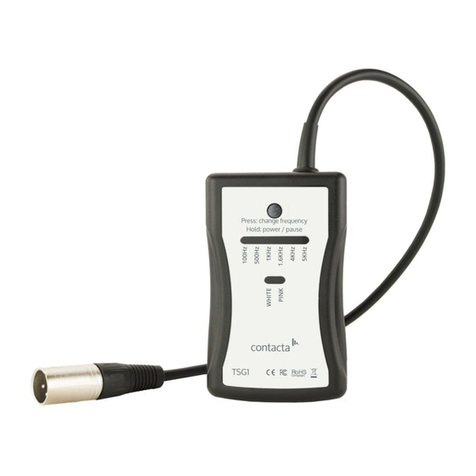
Audio ACCESSIBILITE
Audio ACCESSIBILITE DCTSG1 user guide
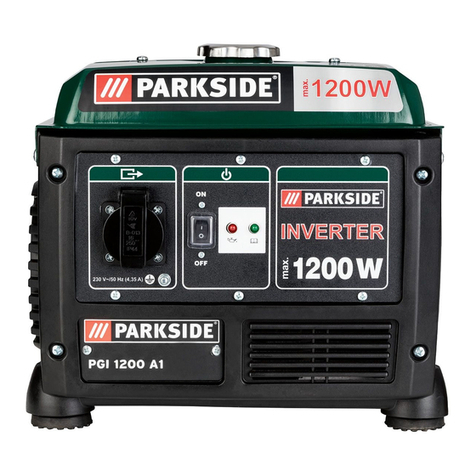
Parkside
Parkside PGI 1200 A1 Operating and Safety Instructions, Translation of Original Operating Manual
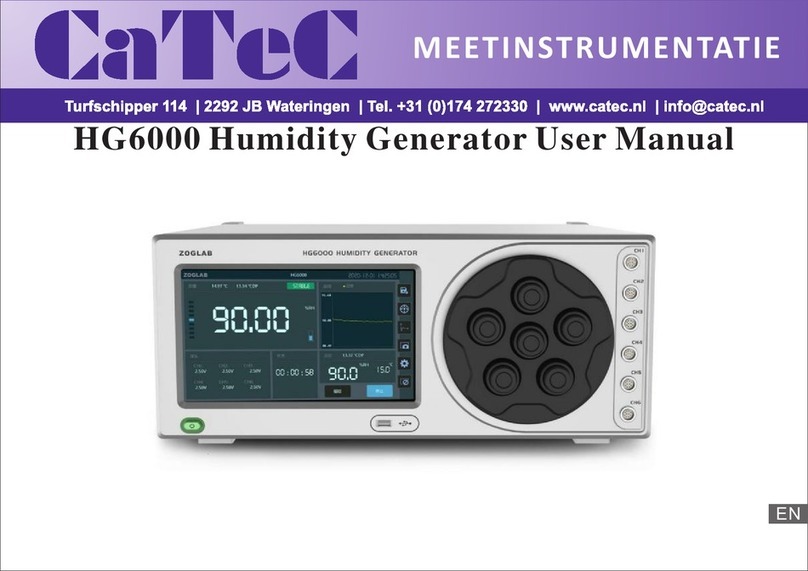
catec
catec ZOGLAB HG6000 user manual

McCulloch
McCulloch 7096-FG6024 user manual
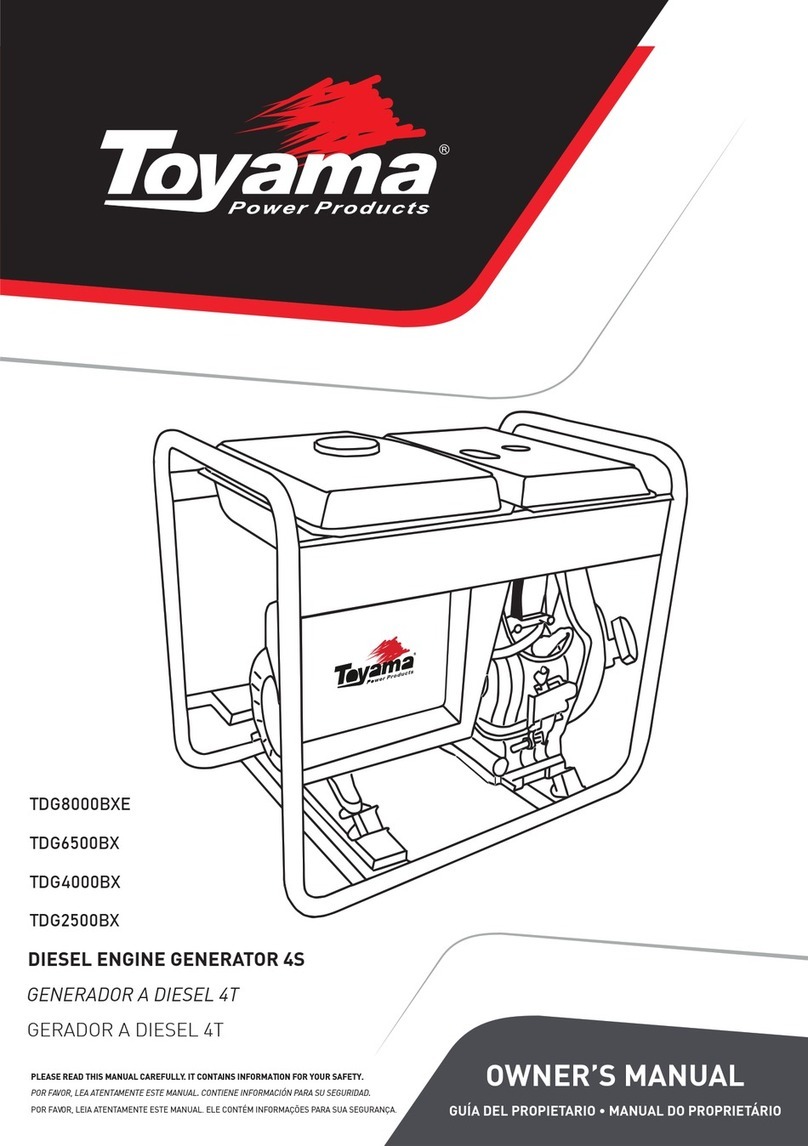
Toyama
Toyama TDG8000BXE owner's manual
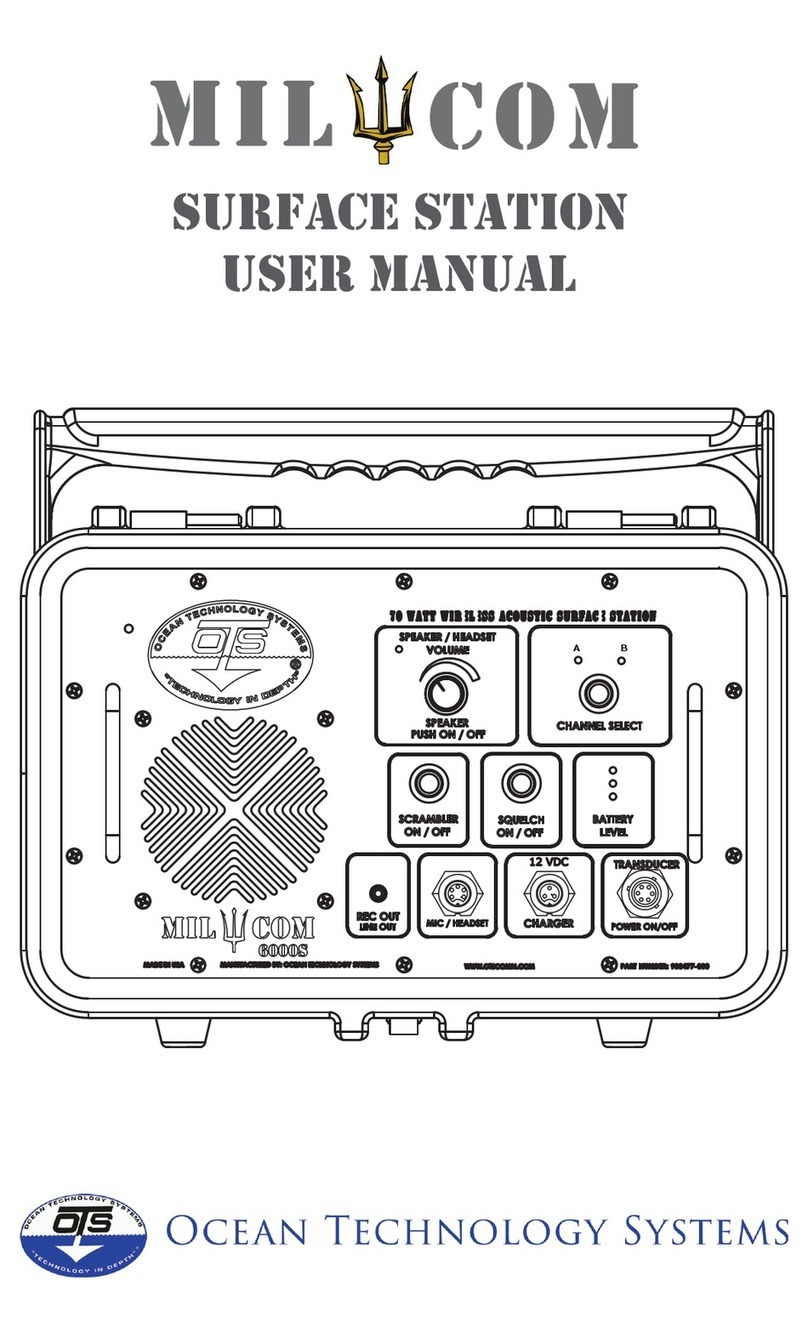
Ocean Technology Systems
Ocean Technology Systems MilCom Surface Station 6000S user manual



